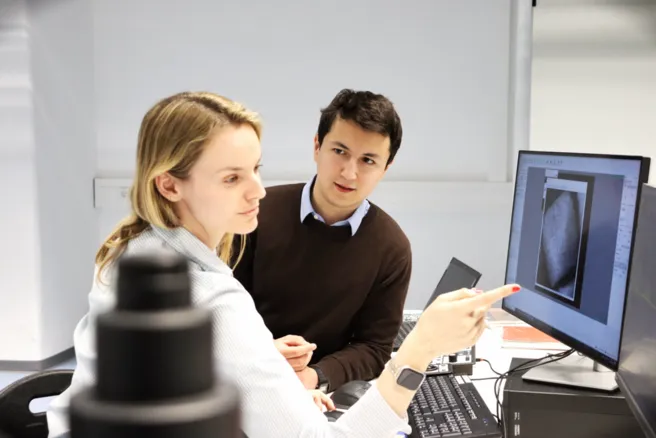Anyone aiming to develop efficient energy materials, such as those used for electrolytic hydrogen production, must think small and dive into the nanocosmos. LMU and TU Munich researchers have developed an innovative method to make porous, DNA-based nanostructures usable for a wide range of applications. This new technique bridges the gap between wet and dry chemistry, significantly expanding the application potential for three-dimensional nanomaterials. The teams, funded by the e-conversion Excellence Cluster and led by Prof. Tim Liedl and Prof. Thomas Bein (both LMU) and Prof. Ian Sharp (TUM), report on how their method for 3D DNA origami works and the opportunities it opens up for sustainable energy technologies in a scientific publication.
The focus lies on constructing large porous structures with homogeneous, precisely defined, and tunable pore sizes, which can play a key role in energy storage, electrocatalysis, and photonics. However, producing such delicate structures on a large scale poses a significant challenge. That’s why the self-assembly of DNA building blocks is a promising approach in nanotechnology: it allows billions of nanostructures to be precisely shaped and formed in aqueous environments. The LMU team led by Prof. Liedl has been successfully employing this approach for over a decade and is considered a global leader in this field. Using DNA origami, they have already formed three-dimensional tetrapod monomers that self-assemble into inverted diamond DNA crystal structures up to 10 µm in size.
Preserving fragile DNA architectures
“The crux, however, is this: to precisely functionalize the complex nanomaterials with metal oxide layers, dry chemistry processes are necessary—which involve high temperatures. These can create undesirable stress within the 3D scaffold,” explains Arthur Ermatov, a PhD student in Prof. Liedl’s group. Researchers had previously used the so-called sol-gel chemistry approach to preserve the structures, in which the three-dimensional DNA architectures were coated with a thin layer of silicon dioxide and then dried. “We have now developed an alternative method using supercritical drying to gently extract the structures from the aqueous solution,” says Ermatov. “The advantage is that we can preserve the DNA crystals without any protective coating and without deformation from surface tension—while maintaining their complex, open structure.”
3D templates for electrocatalytic hydrogen production
The LMU team also demonstrated that these dried nanostructures can be further processed using established dry chemistry methods. In the next step, collaborative research teams from LMU, led by Prof. Thomas Bein, and from TU Munich, led by Prof. Ian Sharp, used atomic layer deposition (ALD) techniques to apply metals and metal oxides onto the DNA crystals. “Using scanning electron microscopy and X-ray spectroscopy, we were able to demonstrate that this method deposits the desired material uniformly across the entire DNA crystal—while preserving the underlying 3D structure, both with and without a protective layer,” explains Ermatov. As a proof of concept, Melisande Kost, a PhD student in Prof. Bein’s group, coated the DNA crystals with iridium oxide and tested the nanomaterial’s electrocatalytic performance. “The most efficient method for electrocatalytic hydrogen production requires the rare compound iridium oxide as a catalyst. That’s why precisely coated nanostructures are essential for optimizing the use of this scarce material,” says Kost. The team observed a significant increase in hydrogen production compared to conventionally coated surfaces. The 3D DNA nanostructure remained stable even under demanding catalytic conditions.
“Our method opens up entirely new possibilities for material design in hydrogen production via electrolysis,” says Prof. Liedl. “The precisely tunable pore structure of our DNA nanocrystals could help further improve catalyst efficiency. That would be a major step toward sustainable energy production.” Another advantage is that the technique is robust, flexible, and modular. This makes it a promising platform for producing custom-designed nanomaterials with diverse applications in photonics, catalysis, and beyond.
Publication:
Fabrication of Functional 3D Nanoarchitectures via Atomic Layer Deposition on DNA Origami Crystals; A. Ermatov, M. Kost, X. Yin, P. Butler, M. Dass, I. D. Sharp, T. Liedl, T. Bein, G. Posnjak
https://doi.org/10.1021/jacs.4c17232
Scientific Contact Person:
Prof. Tim Liedl
Research Group on Molecular Self-Assembly and Nanoengineering
Faculty of Physics and Center for NanoScience (CeNS)
Ludwig-Maximilians-University Munich
Email: tim.liedl(at)physik.lmu.de
Website: https://www.softmatter.physik.uni-muenchen.de/liedl_group/index.html
Original article: https://www.e-conversion.de/dna-origami-catalyst/ (Caroline Zörlein)

